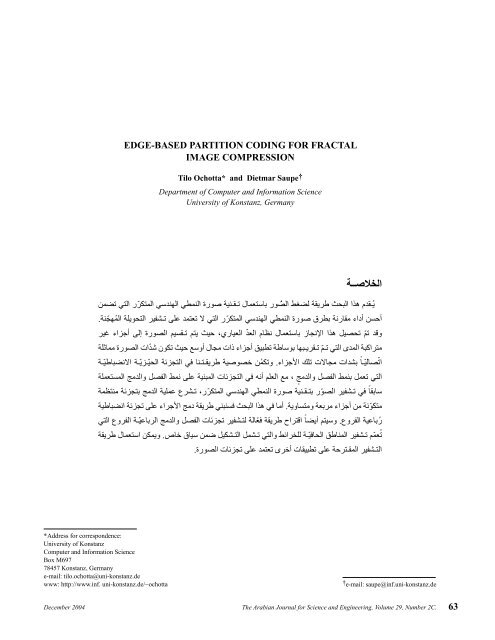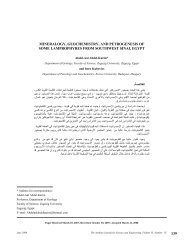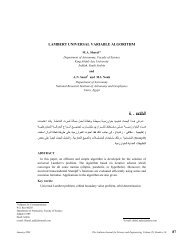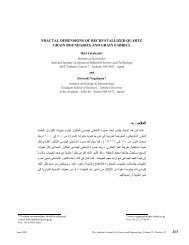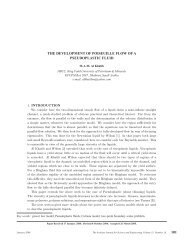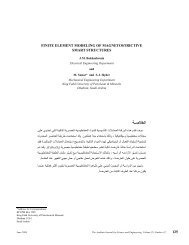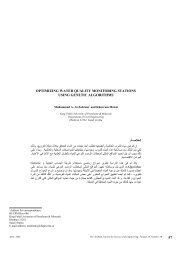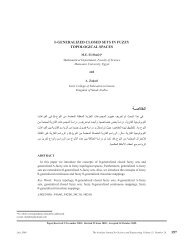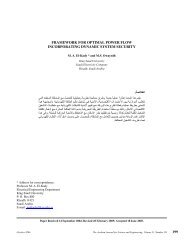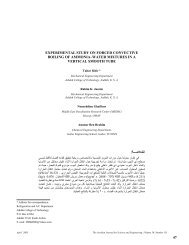Edge-Based Partition Coding for Fractal Image Compression Tilo ...
Edge-Based Partition Coding for Fractal Image Compression Tilo ...
Edge-Based Partition Coding for Fractal Image Compression Tilo ...
Create successful ePaper yourself
Turn your PDF publications into a flip-book with our unique Google optimized e-Paper software.
*Address <strong>for</strong> correspondence:<br />
University of Konstanz<br />
Computer and In<strong>for</strong>mation Science<br />
Box M697<br />
78457 Konstanz, Germany<br />
e-mail: tilo.ochotta@uni-konstanz.de<br />
www: http://www.inf. uni-konstanz.de/~ochotta<br />
EDGE-BASED PARTITION CODING FOR FRACTAL<br />
IMAGE COMPRESSION<br />
<strong>Tilo</strong> Ochotta* and Dietmar Saupe†<br />
Department of Computer and In<strong>for</strong>mation Science<br />
University of Konstanz, Germany<br />
<strong>Tilo</strong> Ochotta and Dietmar Saupe<br />
ﺔــﺻﻼﺨﻟا<br />
ﻦﻤﻀﺗ ﻲﺘﻟا رّﺮﻜﺘﻤﻟا ﻲﺳﺪﻨﻬﻟا ﻲﻄﻤﻨﻟا ةرﻮﺻ ﺔﻴﻨـﻘـﺗ لﺎﻤﻌﺘﺳﺎﺑ رﻮ ُّﺼﻟا ﻂﻐﻀﻟ ﺔﻘﻳﺮﻃ ﺚﺤﺒﻟا اﺬه مﺪﻘـُﻳ<br />
.ﺔﻨ ّﺠﻬُﻤﻟا ﺔﻠﻳﻮﺤﺘﻟا ﺮﻴﻔﺸـﺗ ﻰﻠﻋ ﺪﻤﺘﻌﺗ ﻻ ﻲﺘﻟا رّﺮﻜﺘﻤﻟا ﻲﺳﺪﻨﻬﻟا ﻲﻄﻤﻨﻟا ةرﻮﺻ قﺮﻄﺑ ﺔﻧرﺎﻘﻣ ءادأ ﻦﺴﺣأ<br />
ﺮﻴﻏ ءاﺰﺟأ ﻰﻟإ ةرﻮﺼﻟا ﻢﻴﺴﻘـﺗ ﻢﺘﻳ ﺚﻴﺣ ،يرﺎﻴﻌﻟا ّﺪﻌﻟا مﺎﻈﻧ لﺎﻤﻌﺘﺳﺎﺑ زﺎﺠﻧﻹا اﺬه ﻞﻴﺼﺤﺗ ّﻢﺗ ﺪﻗو<br />
ﺔﻠﺛﺎﻤﻣ ةرﻮﺼﻟا تاّﺪﺷ نﻮﻜﺗ ﺚﻴﺣ ﻊﺳوأ لﺎﺠﻣ تاذ ءاﺰﺟأ ﻖﻴﺒﻄﺗ ﺔﻃﺎﺳﻮﺑ ﺎﻬﺒـﻳﺮﻘـﺗ ّﻢـﺗ ﻲﺘﻟا ىﺪﻤﻟا ﺔﺒﻛاﺮﺘﻣ<br />
ﺔـّﻴﻃﺎﺒﻀﻧﻻا ﺔـّﻳﺰـّﻴﺤﻟا ﺔﺋﺰﺠﺘﻟا ﻲﻓ ﺎﻨـﺘـﻘﻳﺮﻃ ﺔﻴﺻﻮﺼﺧ ﻦُﻤﻜﺗو .ءاﺰﺟﻷا ﻚﻠﺗ تﻻﺎﺠﻣ تاﺪﺸﺑ ً ﺎـّﻴﻟﺎﺼّﺗا<br />
ﺔﻠﻤﻌﺘﺴﻤﻟا ﺞﻣﺪﻟاو ﻞﺼﻔﻟا ﻂﻤﻧ ﻰﻠﻋ ﺔﻴﻨﺒﻤﻟا تﺎﺋﺰﺠﺘﻟا ﻲﻓ ﻪﻧأ ﻢﻠﻌﻟا ﻊﻣ ، ٍ ﺞﻣﺪﻟاو ﻞﺼﻔﻟا ﻂﻤﻨﺑ ﻞﻤﻌﺗ ﻲﺘﻟا<br />
ﺔﻤﻈﺘﻨﻣ ﺔﺋﺰﺠﺘﺑ ﺞﻣﺪﻟا ﺔﻴﻠﻤﻋ عﺮﺸـﺗ ،رّﺮﻜﺘﻤﻟا ﻲﺳﺪﻨﻬﻟا ﻲﻄﻤﻨﻟا ةرﻮﺻ ﺔﻴﻨـﻘـﺘﺑ رّﻮﺼﻟا ﺮﻴﻔﺸـﺗ ﻲﻓ ً ﺎﻘﺑﺎﺳ<br />
ﺔﻴﻃﺎﺒﻀﻧا ﺔﺋﺰﺠﺗ ﻰﻠﻋ ءاﺮﺟﻷا ﺞﻣد ﺔﻘﻳﺮﻃ ﻲﻨﺒﻨﺴﻓ ﺚﺤﺒﻟا اﺬه ﻲﻓ ﺎﻣأ .ﺔﻳوﺎﺴﺘﻣو ﺔﻌﺑﺮﻣ ءاﺰﺟأ ﻦﻣ ﺔﻧّﻮﻜﺘﻣ<br />
ﻲﺘﻟا عوﺮﻔﻟا ﺔـّﻴﻋﺎﺑﺮﻟا ﺞﻣﺪﻟاو ﻞﺼﻔﻟا تﺎﺋﺰﺠﺗ ﺮﻴﻔﺸـﺘﻟ ﺔﻟﺎّﻌﻓ ﺔﻘﻳﺮﻃ حاﺮﺘﻗا ً ﺎﻀﻳأ ﻢﺘﻴﺳو .عوﺮﻔﻟا ﺔﻴﻋﺎﺑُر<br />
ﺔﻘﻳﺮﻃ لﺎﻤﻌﺘﺳا ﻦﻜﻤﻳو .صﺎﺧ قﺎﻴﺳ ﻦﻤﺿ ﻞﻴﻜﺸـﺘﻟا ﻞﻤﺸـﺗ ﻲﺘﻟاو ﻂﺋاﺮﺨﻠﻟ ﺔـّﻴﻓﺎﺤﻟا ﻖﻃﺎﻨﻤﻟا ﺮﻴﻔﺸـﺗ ﻢّﻤﻌُﺗ<br />
.ةرﻮﺼﻟا تﺎﺋﺰﺠﺗ ﻰﻠﻋ ﺪﻤﺘﻌﺗ ىﺮﺧأ تﺎﻘﻴﺒﻄﺗ ﻰﻠﻋ ﺔﺣﺮﺘـﻘﻤﻟا ﺮﻴﻔﺸـﺘﻟا<br />
† e-mail: saupe@inf.uni-konstanz.de<br />
December 2004 The Arabian Journal <strong>for</strong> Science and Engineering, Volume 29, Number 2C. 63
64<br />
<strong>Tilo</strong> Ochotta and Dietmar Saupe<br />
ABSTRACT<br />
This paper presents an approach <strong>for</strong> fractal image compression that yields the best<br />
per<strong>for</strong>mance compared to fractal methods that do not rely on hybrid trans<strong>for</strong>m coding.<br />
The achievement is obtained using the standard algorithm in which the image is<br />
partitioned into non-overlapping range blocks which are approximated by corresponding<br />
larger domain blocks with image intensities that are affinely similar to those of the range<br />
blocks. The particular feature of our approach is the adaptive spatial partition that<br />
proceeds in a split/merge fashion. In previous split/merge partitions <strong>for</strong> fractal image<br />
coding, the merging started from a uni<strong>for</strong>m partition consisting of square blocks of equal<br />
size. In this paper, we base the block merging on an adaptive quadtree partitioning.<br />
An efficient encoding method <strong>for</strong> the quadtree-based split/merge partitions is proposed<br />
which generalizes the coding of region edge maps and which includes special context<br />
modeling. The encoding method may be used <strong>for</strong> other applications that rely on image<br />
partitions.<br />
Key words: <strong>Fractal</strong> <strong>Image</strong> <strong>Compression</strong>, <strong>Partition</strong> <strong>Coding</strong>, Region <strong>Edge</strong> Maps, <strong>Image</strong><br />
Segmentation.<br />
The Arabian Journal <strong>for</strong> Science and Engineering, Volume 29, Number 2C. December 2004
1. INTRODUCTION<br />
EDGE-BASED PARTITION CODING FOR<br />
FRACTAL IMAGE COMPRESSION<br />
<strong>Tilo</strong> Ochotta and Dietmar Saupe<br />
<strong>Fractal</strong> image compression was conceived by Barnsley and Sloan [1, 2], and the first fully automated fractal<br />
image compression algorithm was published by Jacquin in 1989 [3, 4]. Given an image, the encoder finds a<br />
contractive affine image trans<strong>for</strong>mation (fractal trans<strong>for</strong>m) T such that the fixed point of T is close to the given<br />
image in a suitable metric. The decoding is by iteration of the fractal trans<strong>for</strong>m starting from an arbitrary image.<br />
Due to the contraction mapping principle, the sequence of iterations converges to the fixed point of T . Jacquin’s<br />
original scheme showed promising results. Since then, many researchers have improved the original algorithm,<br />
outper<strong>for</strong>ming standard JPEG image compression. However, the rate–distortion per<strong>for</strong>mance of current stateof-the-art<br />
codecs based on wavelet trans<strong>for</strong>m coding as, e.g., in JPEG2000 cannot yet be reached, even by the<br />
best fractal coders that work in the spatial domain. For surveys, detailed discussions, computer code, and<br />
bibliography see [5–7].<br />
The fractal trans<strong>for</strong>m in its common <strong>for</strong>m has two essential components, namely first, an image partition and<br />
second, <strong>for</strong> each block of the partition (called range block) an address <strong>for</strong> a similar image block, called a domain,<br />
and a small set of real quantized trans<strong>for</strong>m parameters. These parameters determine an affine mapping of the<br />
intensity values of the domain block that is shaped like the range block. These mappings are chosen such that<br />
the intensities in each range block are approximated by the trans<strong>for</strong>med intensities of the corresponding domain<br />
block. The fractal trans<strong>for</strong>m T operates on an arbitrary image by mapping domains to ranges as specified in the<br />
fractal code. Contractivity of the trans<strong>for</strong>m may be provided by a simple condition on one of the parameters of<br />
the affine mappings.<br />
Uni<strong>for</strong>m image partitions do not yield satisfying rate–distortion per<strong>for</strong>mance <strong>for</strong> fractal coding. Thus, already<br />
the first papers on fractal compression suggested adaptive image partitions. Jacquin used image squares that<br />
were subdivided into smaller regions consisting of one to three subsquares of half the size [4]. In [5] adaptive<br />
quadtrees were used. These partitions are built with square blocks which are recursively subdivided into four<br />
subblocks of equal size until some approximation quality is reached or the block size falls below a given threshold.<br />
Other hierarchical image partitions can be based on rectangles [8, 9] and polygons [10]. Delaunay triangulations<br />
have also been used [11, 12].<br />
Highly adaptive partitions can be generated by a split/merge scheme [13] in two phases. First, the image is<br />
partitioned into successively smaller blocks until a termination criterion is fulfilled. Then neighboring regions<br />
may be merged again as long as some coherence criterion is satisfied. In the methods in [14–16], the splitting is<br />
simple and results in uni<strong>for</strong>m square blocks. These small squares are merged again to <strong>for</strong>m irregularly shaped<br />
range blocks that adapt well to the structure of the underlying image and provide some of the best fractal coders<br />
[16]. Uni<strong>for</strong>m and quadtree partitions are easy to encode, comprising just a small fraction of the total rate in a<br />
fractal image code. However, more adaptive partitions such as those based on a split/merge process are harder to<br />
encode efficiently. There are two main approaches. One may either encode the boundaries of the image regions,<br />
or one can encode connectivity of the basic blocks that make up the image regions. Chain coding [17] belongs<br />
to the first category, while region edge maps [18] are an example <strong>for</strong> the second kind.<br />
Our work extends and improves the methods in [16] in two ways.<br />
(1) In 1976 Horowitz and Pavlidis [19] suggested a split/merge scheme <strong>for</strong> efficient image representation in<br />
which the splitting provided a quadtree partition whose blocks are then merged to <strong>for</strong>m adaptive image<br />
regions. Such image partitions can also be generated when splitting all the way down to equal sized<br />
squares. However, due to the occurrence of larger coherent blocks in the underlying quadtree partition<br />
December 2004 The Arabian Journal <strong>for</strong> Science and Engineering, Volume 29, Number 2C. 65
66<br />
<strong>Tilo</strong> Ochotta and Dietmar Saupe<br />
a more efficient code of the partition may be expected, without significantly reducing the adaptivity of<br />
the final partition. Thus, we propose to use this approach in the context of fractal coding. We note that<br />
this has already been tried in [20, 21].<br />
(2) Our main contribution is an efficient method to encode the corresponding split/merge partition, i.e., an<br />
image partition in which each block is the union of some neighboring square blocks from a given quadtree<br />
partition, which must also be encoded efficiently. For this purpose, we generalize the region edge maps<br />
proposed in [18], and provide comprehensive context modelling <strong>for</strong> efficient arithmetic encoding.<br />
The rest of the paper is organized as follows. In Section 2 we briefly review the basics about fractal image<br />
coding and give a short survey of previous work in the field of lossless partition coding that is relevant with<br />
respect to our approach. In particular, we revisit region edge maps which provide the basis of our new method<br />
<strong>for</strong> quadtree-based region edge maps. In Section 3 we define a compression scheme <strong>for</strong> quadtree codes and<br />
introduce quadtree-based region edge maps and their efficient encoding with context modelling. In Section 4<br />
we apply the proposed scheme to region-based fractal image compression providing efficient partition coding.<br />
Experimental results are presented in Section 5.<br />
2. TERMINOLOGY AND RELATED WORK<br />
2.1. <strong>Fractal</strong> <strong>Image</strong> <strong>Compression</strong><br />
We consider an image F of size N × N as a function that maps a set of N 2 pixel coordinates (x, y), x, y =<br />
0,...,N − 1, to the set of grey values v ∈{0,...,255}. The function F may be represented as a corresponding<br />
set of 3-tuples (x, y, v). A base block b is an n × n subset of F , b = {(x, y, v) ∈ F | x = xmin,...,xmax,y =<br />
ymin,...,ymax} where xmax − xmin = ymax − ymin = n − 1. The base block size n is a fixed parameter of our<br />
method and may be chosen as small as n = 1 amounting to base blocks being single pixels. For our image partition<br />
we need to consider groups of connected base blocks as range blocks <strong>for</strong> the fractal coder. We call two base<br />
blocks b1, b2, b1 ∩ b2 = ∅ adjacent, if and only if there are two pixels p1 =(x1,y1,v1) ∈ b1, p2 =(x2,y2,v2) ∈ b2<br />
such that |x2 − x1| + |y2 − y1| = 1. We define a region as a connected set of base blocks. A set of regions<br />
P = {ri | i =0,...,nR − 1} with ri = rj and ri ∩ rj = ∅ <strong>for</strong> i = j which covers the image F , i.e., ∪r∈P r = F ,<br />
is called a partition of F .<br />
The image F in a range block is approximated by an intensity trans<strong>for</strong>med copy of a larger block, called a<br />
domain block. Let us denote by DF the domain image of size N/2 × N/2 obtained by downsampling the original<br />
N × N image F . Usually, downsampling proceeds by averaging intensity values of pixels in 2 × 2 blocks. For a<br />
given range block r parameters xd,yd ∈{0,...,N/2 − 1} and sr,or ∈ R are sought such that<br />
v ≈ ˆv = sr · DF ((x + xd) modN/2, (y + yd) modN/2) + or, (x, y, v) ∈ r. (2.1)<br />
The region that is addressed with (xd,yd) in the domain image D and the same shape as the range block is the<br />
domain block <strong>for</strong> the range r. The parameters sr and or allow scaling and adjustment of brightness of the grey<br />
values of the domain. Scaling factors are chosen with the constraint |sr| < 1. Moreover, scaling factors sr and<br />
offsets or are quantized <strong>for</strong> the purpose of encoding.<br />
We also consider an approximation error <strong>for</strong> mapping (2.1):<br />
E(r) = <br />
(v − ˆv) 2 . (2.2)<br />
(x,y,v)∈r<br />
The approximation error E(r) should be as small as possible. Typically, least squares optimization is used<br />
to determine the best scaling factor and offset <strong>for</strong> a given domain address (xd,yd), and a search through a<br />
The Arabian Journal <strong>for</strong> Science and Engineering, Volume 29, Number 2C. December 2004
<strong>Tilo</strong> Ochotta and Dietmar Saupe<br />
pool of domains determines the domain which yields the least approximation error. We also consider a global<br />
approximation error <strong>for</strong> the image F which is called collage error:<br />
E = E(F, P) = <br />
E(r). (2.3)<br />
r∈P<br />
The fractal code must uniquely describe the image partition and <strong>for</strong> each range block in the partition the domain<br />
block used together with the scaling factor and the offset. This code essentially amounts to the definition of an<br />
image operator T . Given an image Ik, the trans<strong>for</strong>med image Ik+1 = T (Ik) is obtained by applying all range<br />
block trans<strong>for</strong>mations in (2.1), where the domain blocks are taken from the image Ik in place of F . This image<br />
operator T is a contraction and, hence, iterating T starting with an arbitrary initial image I0 converges to a<br />
unique image I ⋆ , the fixed point of the fractal trans<strong>for</strong>m T . The fixed point I ⋆ can be constructed by the decoder<br />
and serves as the image reconstruction. The reconstruction quality depends on the collage error 2.3, which is<br />
due to the so-called collage theorem. For further details, background material, and proofs we refer to the large<br />
body of literature, see, e.g., [5, 22, 23].<br />
2.2. Lossless <strong>Partition</strong> <strong>Coding</strong><br />
There are two classes <strong>for</strong> lossless partition coding. The first one is chain coding in which sequences of symbols<br />
<strong>for</strong> directions represent region boundaries [17]. A naive chain coding <strong>for</strong> image partitions encodes the closed<br />
boundary of each region as a starting position and a sequence of steps in the directions North, East, South, and<br />
West. This approach is not satisfying. The reason is that boundary segments are encoded twice because an<br />
edge is shared by two neighboring regions except at the image boundary. Furthermore, the encoding of the start<br />
positions can become expensive in bits even when the absolute address <strong>for</strong> a region is encoded relative to another<br />
one. Several optimizations have been introduced, e.g., in [24], where three symbols are used to represent a chain<br />
(go straight, left, or right). In [25] the partition is not coded as a set of closed region boundaries but as set of line<br />
sequences. Each sequence describes a number of connected lines <strong>for</strong> which a relative starting point, the length<br />
of each line, and the relative directions of the line segments are encoded. Each region edge is visited only once<br />
and long straight lines can be encoded by a small number of symbols. Other, more sophisticated, methods <strong>for</strong><br />
chain coding (in the context of fractal image coding) are in our previous paper [26].<br />
The second class of methods to represent region shapes is related to encoding binary images. A fundamental<br />
method <strong>for</strong> compressing black-and-white images has been proposed in [27]. The binary intensities are encoded<br />
individually in line-by-line order using an arithmetic coder [28] with context modelling. In [18], this approach<br />
was extended to encode grid-based partitions in which the connectivity of a base block is encoded with one out<br />
of four symbols each. For a given base block it suffices to indicate whether its Northern and Western borders are<br />
part of a region boundary, which requires two bits per base block (see Figure 1(a)). The resulting 4-nary image<br />
is called a region edge map.<br />
0<br />
2 3<br />
1 NW N NE<br />
W<br />
X<br />
NW N NE<br />
(a) (b) (c)<br />
Figure 1. Region edge maps with context modeling: (a) a block is represented by a symbol from {0, 1, 2, 3} which encodes<br />
the presence resp. absence of region edges at the Northern and Western boundary of the block; (b) the symbols of four<br />
preceding blocks (West, North West, North, and North East) are used to define a context; (c) the symbol combination<br />
N =1, W =2, X =2cannot occur in a partition.<br />
December 2004 The Arabian Journal <strong>for</strong> Science and Engineering, Volume 29, Number 2C. 67<br />
W<br />
X
68<br />
<strong>Tilo</strong> Ochotta and Dietmar Saupe<br />
Table 1. Impossible Symbol Combinations.<br />
W NE N NW X<br />
0 * 0 * 1<br />
0 * 0 * 2<br />
0 * 1 * 1<br />
0 * 1 * 2<br />
0 * 2 * 0<br />
0 * 3 * 0<br />
1 * 0 * 0<br />
1 * 1 * 0<br />
W NE N NW X<br />
2 * 0 * 1<br />
2 * 0 * 2<br />
2 * 1 * 1<br />
2 * 1 * 2<br />
2 * 2 * 0<br />
2 * 3 * 0<br />
3 * 0 * 0<br />
3 * 1 * 0<br />
The asterisks correspond to any symbol {0,...,3}.<br />
All in all 768 out of 4 5 = 1024 combinations may occur.<br />
In [18] the symbols of a region edge map are encoded line-by-line with an adaptive arithmetic coder and<br />
context modelling similar to [27]. The context modelling (Figure 1(b)) uses four previously encoded/decoded<br />
symbols (symbols <strong>for</strong> blocks in West, North West, North and North East direction). Due to elementary geometric<br />
facts some symbol combinations cannot occur (Figure 1(c), Table 1). Taking this into account, the following<br />
<strong>for</strong>mula is proposed to update the probability p <strong>for</strong> a symbol z, that may appear in context c:<br />
p(z|c) =<br />
λ · count(z|c)+1<br />
, (2.4)<br />
λ · count(c)+|Ac|<br />
where count(z|c) is the number of symbols z encoded in context c, count(c) is the total number of occurrences of<br />
context c, and |Ac| ≤4 is the number of symbols that are possible in context c. Probabilities p(z|c) <strong>for</strong> symbols<br />
z that are not possible in context c as indicated in Table 1 are set to zero. Following the experimental results in<br />
[18], the weight factor λ should be set to 4 or 5 <strong>for</strong> best compression results. In our empirical studies we used<br />
λ =4.<br />
3. PARTITION CODING METHOD<br />
3.1. Quadtree Decomposition<br />
Our partition method is based on a split/merge approach as introduced by Horowitz and Pavlidis in [19].<br />
In our case, the splitting phase consists of a quadtree segmentation. Tate’s edge-based coding scheme [18] uses<br />
a uni<strong>for</strong>m grid of equally sized square base blocks. In this section, we extend the coding to partitions in which<br />
regions are unions of square base blocks from a quadtree segmentation.<br />
A quadtree is a hierarchical data structure [29] amounting to an ordered tree with inner nodes of degree four.<br />
In image processing applications a node corresponds to a rectangular (or square) image area, which is recursively<br />
split into four equal size subrectangles (or subsquares) corresponding to the four children of the node. A split<br />
rule evaluated <strong>for</strong> a given node, respectively the corresponding rectangle (square), determines termination of<br />
the recursion, in which case the node ends up as a leaf node of the quadtree. The blocks belonging to the leaf<br />
nodes of the tree comprise the quadtree partition. By means of the split criterion, the quadtree may adapt to<br />
The Arabian Journal <strong>for</strong> Science and Engineering, Volume 29, Number 2C. December 2004
<strong>Tilo</strong> Ochotta and Dietmar Saupe<br />
image content. For example, large blocks in low frequency areas and small blocks in high frequency areas can be<br />
generated, respectively. Pseudo code <strong>for</strong> the procedure is given in Algorithm 1.<br />
After quadtree segmentation, an iterative merging phase follows where in each iteration two adjacent blocks<br />
are merged, which may be further merged with other blocks in a succeeding iteration. An application specific<br />
merge criterion, evaluated <strong>for</strong> each pair of adjacent blocks to be merged, determines two blocks that are merged<br />
in an iteration step. Pseudo code <strong>for</strong> the procedure is given in Algorithm 2.<br />
During the merging process it is possible that a group of four blocks belonging to four child nodes of the same<br />
parent node in the quadtree are merged into one region. In such a case it is possible to simplify the quadtree by<br />
pruning it at the parent node. We call the resulting quadtree a fitted quadtree and expect to be able to encode<br />
the fitted quadtree as well as the quadtree-based regions of the final image partition with a smaller rate.<br />
3.2. Quadtree <strong>Coding</strong><br />
Algorithm 1 split(n)<br />
Input: quadtree leaf node n with corresponding image block r(n).<br />
Output: quadtree root node n with corresponding quadtree partition of r(n).<br />
• split criterion is given by boolean function SC(·).<br />
if SC(r(n)) then<br />
expand the node n using four child nodes ni,i=0, ..., 3<br />
<strong>for</strong> i=0,. . . ,3 do<br />
• ni = split(ni)<br />
end <strong>for</strong><br />
end if<br />
return node n.<br />
Algorithm 2 merge(P ,nR)<br />
Input: quadtree partition P , target region number nR < |P |.<br />
Output: partition P ′ with |P ′ | = nR regions.<br />
• Set P ′ = ∅.<br />
<strong>for</strong> all q ∈ P do<br />
• initialize q as region r<br />
• insert r into P ′<br />
end <strong>for</strong><br />
while |P ′ | >nR do<br />
• find the region pair (ri,rj), ri,rj neighbors in P ′ minimizing an error criterion<br />
• insert ri ∪ rj into P ′<br />
• remove ri and rj from P ′<br />
end while<br />
return P ′ .<br />
In this subsection we describe the encoding of the quadtree partition. The following subsection covers the<br />
encoding of the image partition derived from merging quadtree blocks. The (ordered) quadtree (Figure 2(a),(b))<br />
is traversed in depth-first order processing each node by outputting a binary symbol 1 <strong>for</strong> an inner node and<br />
0 <strong>for</strong> a leaf node. Since we also encode the smallest and largest depth of a leaf node as side in<strong>for</strong>mation, we<br />
may delete the symbols 1 <strong>for</strong> inner nodes above the minimal leaf depth and the symbols 0 <strong>for</strong> leaf nodes at the<br />
maximal depth.<br />
Context-based arithmetic coding is crucial <strong>for</strong> obtaining compact codes <strong>for</strong> quadtrees. For example, context<br />
modelling can exploit the fact that situations given by one large quadtree block adjacent to many small quadtree<br />
December 2004 The Arabian Journal <strong>for</strong> Science and Engineering, Volume 29, Number 2C. 69
70<br />
<strong>Tilo</strong> Ochotta and Dietmar Saupe<br />
1<br />
2<br />
3 4<br />
(a)<br />
(b) (c)<br />
Figure 2. Quadtree decomposition after the top down scheme: (a) stepwise split up of the blocks; (b) encoding order;<br />
(c) situation with low probability of occurrence: one block q has many neighbor blocks.<br />
blocks (Figure 2(c)) seldomly occur. For a given block q we consider the number of neighboring leaves in North<br />
and West (zN and zW respectively). These numbers are known also at the decoder due to the depth-first<br />
traversal of the quadtree. These counts are bounded, 0 ≤ zN , zW ≤ zmax, where zmax is determined by the<br />
side in<strong>for</strong>mation (minimal and maximal depth of leaf nodes). For example, zmax = 8 <strong>for</strong> a 4–32-quadtree, i.e., a<br />
quadtree segmentation in which the minimal and maximal block sizes are 4 × 4 and 32 × 32, respectively.<br />
We propose the following three heuristic schemes to build up a context <strong>for</strong> the given block q. In the last<br />
subsection we empirically compare the per<strong>for</strong>mance of these three context models <strong>for</strong> quadtree partitions of<br />
varying complexity <strong>for</strong> test images.<br />
Full Context: Two symbols are defined to be in the same context class if and only if the corresponding<br />
tuples (zN,zW ) of neighbor leaf numbers are equal. If we number the context classes by c =0, ..., cmax−1,<br />
we may write c =(zmax +1)zN + zW and cmax =(zmax +1) 2 .<br />
Sum Context: Two symbols are in the same context class if and only if the corresponding combined<br />
neighbor leaf numbers, i.e., zN + zW , are equal. Thus, c = zN + zW and cmax =2· (zmax + 1).<br />
Reduced Context: Four context classes are defined by checking whether there are several neighboring<br />
leaf nodes in the North and in the West. More precisely,<br />
⎧<br />
⎪⎩<br />
and cmax =4.<br />
0 <strong>for</strong> zN ≤ 1 and zW ≤ 1<br />
⎪⎨ 1<br />
c =<br />
<strong>for</strong> zN ≤ 1 and zW ≥ 2<br />
2 <strong>for</strong> zN ≥ 2 and zW ≤ 1<br />
3 <strong>for</strong> zN ≥ 2 and zW ≥ 2<br />
3.3. Quadtree-based Region <strong>Edge</strong> Maps<br />
In this subsection we generalize the region edge map (REM) encoding scheme described in Subsection 2.2 to<br />
the case where the blocks used in the merging phase are from a quadtree image partition.<br />
The Arabian Journal <strong>for</strong> Science and Engineering, Volume 29, Number 2C. December 2004<br />
q
c<br />
v t<br />
c<br />
v n<br />
c<br />
c<br />
h n<br />
i<br />
h n<br />
i<br />
c<br />
c<br />
c<br />
c c<br />
c<br />
v t<br />
v n<br />
v n<br />
c<br />
h n<br />
i<br />
<strong>Tilo</strong> Ochotta and Dietmar Saupe<br />
December 2004 The Arabian Journal <strong>for</strong> Science and Engineering, Volume 29, Number 2C. 71<br />
c<br />
v n<br />
h n<br />
i i<br />
i<br />
h n<br />
i<br />
h t<br />
i<br />
i<br />
i i i<br />
Figure 3. Types of atomic blocks in quadtree-based region edge maps: corner blocks (c); interior blocks (i); trivial<br />
horizontal boundary blocks (ht); nontrivial horizontal boundary block (hn); trivial vertical boundary blocks (vt); and<br />
nontrivial vertical boundary blocks (vn).<br />
We assume that the encoding of the split/merge partition occurs after encoding the quadtree partition as<br />
given in the last Subsection 3.2. Thus, we may use the quadtree partition in the context modelling. We first note<br />
that the split/merge partition based on merging blocks of the quadtree partition can easily be encoded using the<br />
previous method <strong>for</strong> REM encoding when we define the region edge map in terms of a uni<strong>for</strong>m image partition<br />
consisting of atomic blocks of the size that is given by the smallest blocks that occur in the quadtree partition.<br />
In other words, we imagine expanding the quadtree so that it becomes a full quadtree (all leaves have the same<br />
depth) and define a symbol z ∈{0, 1, 2, 3} <strong>for</strong> each leaf block depending on the presence of a region boundary<br />
along its Western and Northern edges as be<strong>for</strong>e (Figure 1(a)). We again encode the resulting symbol sequence<br />
line by line from top to bottom and from left to right. Let us call this symbol sequence the quadtree-based<br />
region edge map (QBREM). This sequence typically has many more symbols than there are blocks in the initial<br />
quadtree partition. However, since the quadtree is available at the coder and the decoder we may use it in order<br />
to design the context modelling to take advantage of this knowledge. For example, in this way the decoder is<br />
able to completely determine many symbols from their context alone without any additional in<strong>for</strong>mation.<br />
With the context modelling <strong>for</strong> region edge maps of Subsection 2.2 the coder maintains a table of up to four<br />
probabilities <strong>for</strong> each of 256 contexts. With the quadtree in the background we can differentiate between six<br />
types of atomic blocks (Figure 3), <strong>for</strong> each of which we propose to maintain a separate probability table. Some<br />
of these tables are trivial, however, and need not be explicitly implemented in a computer program. In the<br />
following paragraphs we describe the six cases and the facts that determine the structure of the corresponding<br />
probability tables.<br />
Case 1 (corner block). The neighboring atomic block in the West and the block in the North do not<br />
belong to the quadtree block that contains the given corner block, see the blocks marked by “c” in<br />
Figure 3. In this case the quadtree partition does not lead to a simplification of the probability table.<br />
Thus, <strong>for</strong> corner blocks the same context model is used as in usual REM coding (Subsection 2.2).<br />
Case 2 (interior block). The neighboring atomic blocks in the West and in the North both belong to<br />
the quadtree block that contains the given interior block, see the blocks marked by “i” in Figure 3.<br />
For such an interior block it is clear that neither the Northern nor the Western edge is a region edge.<br />
Thus, the symbol <strong>for</strong> any interior atomic block in a QBREM must be equal to 0. Formally, we may set<br />
the probability <strong>for</strong> symbol 0 equal to 1 <strong>for</strong> all of the 256 contexts, while all other probabilities are zero.<br />
Encoding the symbol 0 <strong>for</strong> an interior block does not require any rate.<br />
Case 3 (horizontal boundary block). The neighboring atomic block in the West belongs to the quadtree<br />
block that contains the given horizontal boundary block, while the neighboring atomic block in the North
72<br />
<strong>Tilo</strong> Ochotta and Dietmar Saupe<br />
does not, see the blocks marked by “ht” and “hn” in Figure 3. In this case we further differentiate<br />
between a trivial and a nontrivial subcase.<br />
Case 3a (trivial horizontal boundary block). The neighboring atomic blocks in the North and in the<br />
North–West both belong to the same quadtree block, see the blocks marked by “ht” in Figure 3. This case<br />
is trivial because the symbol <strong>for</strong> the atomic block is already determined by that of the preceding block<br />
in the West. The atomic block has a region edge at its Northern edge if and only if the same holds <strong>for</strong><br />
the neighboring block in the West. In terms of the probability table, it can be seen that the probability<br />
<strong>for</strong> symbol X = 1 must be set to 1 if W =1orW = 3, and the probability <strong>for</strong> symbol X = 0 must<br />
be set to 1 if W =0orW = 2. As <strong>for</strong> interior blocks, these trivial horizontal boundary blocks do not<br />
require any rate <strong>for</strong> encoding.<br />
Case 3b (nontrivial horizontal boundary block). The neighboring atomic blocks in the North and in<br />
the North–West belong to different quadtree blocks, see the block marked by “hn” in Figure 3. For these<br />
blocks, we can exploit only the fact that the neighbor in the West belongs to the same quadtree block and,<br />
thus, the Western edge of a nontrivial horizontal boundary block cannot be a part of a region boundary.<br />
For the probability table this implies that in addition to the simplification due to the impossible cases<br />
listed in Table 1 we have that the probabilities <strong>for</strong> the symbols X = 2 and X = 3 must both be zero <strong>for</strong><br />
all context cases. For many of the contexts this lead to trivial cases. For example, suppose W = 0 and<br />
N = 0. Then X = 1 and X = 2 are ruled out, see Table 1. Since also X = 3 cannot occur <strong>for</strong> nontrivial<br />
horizontal boundary blocks, we conclude that only X = 0 is possible.<br />
Case 4 (vertical boundary block). The neighboring atomic block in the North belongs to the quadtree<br />
block that contains the given vertical boundary block, while the neighboring atomic block in the West<br />
does not; see the blocks marked by “vn” and “vt” in Figure 3. Naturally, this case is similar to that of<br />
a horizontal boundary block discussed above. To complete the list of cases, we just state the trivial and<br />
the nontrivial subcases below omitting the details which are identical to Cases 3a and 3b except <strong>for</strong> an<br />
appropriate and straight<strong>for</strong>ward adaptation.<br />
Case 4a (trivial vertical boundary block).<br />
Case 4b (nontrivial vertical boundary block).<br />
Consider the case of nontrivial horizontal and vertical boundary blocks from Cases 3b and 4b above. We may<br />
ask which of the 256 contexts <strong>for</strong> either case leads to a nontrivial list of probabilities <strong>for</strong> the symbols X =0, 1<br />
(Case 3b) orX =0, 2 (Case 4b). Taking into account Table 1 we deduce that the only contexts in which the<br />
symbol X is not already uniquely determined is given by W =1orW = 2 and N =2orN = 3. This holds<br />
<strong>for</strong> nontrivial horizontal as well as vertical boundary blocks. Together with NW,NE =0, 1, 2, 3 we obtain<br />
64 contexts in which X ∈{0, 1} <strong>for</strong> horizontal boundary blocks and X ∈{0, 2} <strong>for</strong> vertical boundary blocks.<br />
For simplicity and in order to avoid context dilution due to an insufficient number of occurrences of nontrivial<br />
boundary blocks we have joined the probability tables in our implementation <strong>for</strong> the horizontal and vertical<br />
cases, listing probabilities only <strong>for</strong> X = 0 and X = 0.<br />
Special cases should also be considered <strong>for</strong> blocks at the Western and Northern image border, which is known<br />
to <strong>for</strong>m region boundaries throughout. We omit these details. Alternatively, one may allow range blocks to wrap<br />
around image boundaries [16].<br />
The proposed context modelling above yields larger probability tables than <strong>for</strong> the case of region edge maps<br />
without quadtree structure. For small images or <strong>for</strong> coarse quadtree partitions smaller context models may be<br />
preferable in order to avoid the context dilution problem. There<strong>for</strong>e we also consider reduced context models<br />
in which some of the tables are merged. In a first step we may ignore the dependence on the symbol <strong>for</strong> the<br />
North East neighbor. Then we may drop the neighbors in the North West, North, and finally also the West.<br />
Table 2 shows how the number of non-redundant probabilities in the tables is reduced accordingly. The resulting<br />
The Arabian Journal <strong>for</strong> Science and Engineering, Volume 29, Number 2C. December 2004
<strong>Tilo</strong> Ochotta and Dietmar Saupe<br />
different context models are called QBREM{num}, where num = 0,..., 4 is the number of neighboring blocks used<br />
in the context model. In the same way, we define REM{0,1,2,3,4}, in which case only one table of probabilities<br />
is needed, whose size is the same as that <strong>for</strong> Case 1 of QBREM.<br />
Table 2. (QB)REM with Different Context Models.<br />
Type Neighbor blocks used in context Probs. Case 1 Probs. Case 3b/4b<br />
(QB)REM0 – 4 2<br />
(QB)REM1 West 16 4<br />
(QB)REM2 West, North 64 8<br />
(QB)REM3 West, North West, North 192 32<br />
(QB)REM4 West, North West, North, North East 768 128<br />
The right hand columns list the number of (nontrivial) probabilities that need to be maintained<br />
in the tables of the context model.<br />
3.4. Results <strong>for</strong> <strong>Partition</strong> <strong>Coding</strong><br />
We used our fractal image coder to produce a sequence of quadtree-based image partitions with varying<br />
numbers of regions. Here we consider only the per<strong>for</strong>mance of the encoding of the octrees alone and the partitions<br />
including the octrees. In Figure 4 we show the rates (cost in bits) <strong>for</strong> QBREM{2,3,4} compared to REM*. Here<br />
by REM* we mean that each of REM{0,1,2,3,4} has been tried and the context template with the lowest costs<br />
was taken at each point. In Figure 4(a) the encoding of the quadtree alone is studied. For the complete quadtree<br />
(with 32 384 leaves), the costs vanish. Regarding the different proposed context models, we observed that the<br />
sum context is least efficient, whereas the sum context and the reduced context have a better and comparable<br />
per<strong>for</strong>mance. Thus, in all further experiments we use the reduced context <strong>for</strong> encoding quadtrees. Figures 4(b–f )<br />
show the costs of the entire partition coding based on 4–32-quadtrees with various numbers of blocks. Generally,<br />
the partition coding with quadtree-based region edge maps is superior to that using plain region edge maps,<br />
which in turn is better than the chain coding given by [21]. The advantage of QBREM is especially large when<br />
the partition is based on quadtrees with relatively few blocks.<br />
If the number of quadtree blocks is very large compared to the number of regions <strong>for</strong>med by merging (see<br />
Figure 4(b) and (e)), then coding the REMs is more economical than coding QBREMs. However, this drawback<br />
can be eliminated by using the quadtree fitting procedure explained in Subsection 3.1, see Figure 4(e).<br />
4. FRACTAL IMAGE CODING<br />
In this section we present implementation details of our fractal coding method. In particular we explain the<br />
parameters that must be chosen in the method.<br />
4.1. Domain Pool and Coefficients<br />
As usual [4], we consider domain blocks that are twice as large as range blocks. In [21, 30], it has been shown<br />
that domains with small collage error may be found near the range block. We make use of this observation by<br />
defining a square array of L 2 domains which is centered over the corresponding range. Two neighboring domains<br />
are offset horizontally or vertically by a fixed step size d (Figure 5). Domain blocks may wrap around image<br />
December 2004 The Arabian Journal <strong>for</strong> Science and Engineering, Volume 29, Number 2C. 73
74<br />
<strong>Tilo</strong> Ochotta and Dietmar Saupe<br />
Costs [bits]<br />
Costs [bits]<br />
Costs [bits]<br />
Costs [bits]<br />
3000<br />
2500<br />
2000<br />
1500<br />
1000<br />
500<br />
14000<br />
12000<br />
10000<br />
8000<br />
6000<br />
4000<br />
2000<br />
sum context<br />
full context<br />
4 context<br />
0<br />
0 4000 8000 12000 16000<br />
Quadtree Blocks<br />
The Arabian Journal <strong>for</strong> Science and Engineering, Volume 29, Number 2C. December 2004<br />
Costs [bits]<br />
20000<br />
18000<br />
16000<br />
14000<br />
12000<br />
10000<br />
8000<br />
6000<br />
4000<br />
2000<br />
0<br />
10613 quadtree blocks<br />
0 2000 4000 6000 8000 10000 12000<br />
Regions<br />
(a) (b)<br />
6715 quadtree blocks<br />
0<br />
0 1000 2000 3000 4000 5000 6000 7000<br />
Regions<br />
REM*<br />
QBREM4<br />
QBREM3<br />
QBREM2<br />
Costs [bits]<br />
12000<br />
10000<br />
8000<br />
6000<br />
4000<br />
2000<br />
0<br />
0<br />
Regions<br />
REM*<br />
QBREM4<br />
QBREM3<br />
QBREM2<br />
4201 quadtree blocks<br />
500<br />
1000<br />
1500<br />
2000<br />
(c) (d )<br />
2449 quadtree blocks<br />
8000<br />
7000<br />
6000<br />
5000<br />
4000<br />
3000<br />
2000<br />
1000<br />
REM*<br />
QBREM4<br />
QBREM3<br />
QBREM2<br />
0<br />
0 500 1000 1500 2000 2500<br />
Regions<br />
16000<br />
14000<br />
12000<br />
10000<br />
8000<br />
6000<br />
4000<br />
2000<br />
0<br />
0<br />
500 1000150020002500<br />
Costs [bits]<br />
5500<br />
5000<br />
4500<br />
4000<br />
3500<br />
3000<br />
2500<br />
2000<br />
1500<br />
1000<br />
500<br />
0<br />
2500<br />
REM*<br />
QBREM4<br />
QBREM3<br />
QBREM2<br />
1588 quadtree blocks<br />
REM*<br />
QBREM4<br />
QBREM3<br />
QBREM2<br />
3000<br />
3500<br />
4000<br />
4500<br />
0 200 400 600 800 1000 1200 1400 1600<br />
Regions<br />
(e) (f )<br />
6715 quadtree blocks<br />
REM*<br />
QBREM*<br />
fit QBREM*<br />
Regions<br />
3000<br />
3500<br />
40004500<br />
5000<br />
Costs [bits]<br />
12000<br />
10000<br />
8000<br />
6000<br />
4000<br />
2000<br />
3223 quadtree blocks<br />
Chain Codes<br />
REM*<br />
QBREM*<br />
0<br />
0 500 1000 1500 2000 2500 3000 3500<br />
Regions<br />
(g) (h)<br />
Figure 4. <strong>Coding</strong> per<strong>for</strong>mance <strong>for</strong> quadtree-based region edge maps (QBREM) compared to plain region edge maps<br />
(REM) <strong>for</strong> partitions of the 512 × 512-Lenna image based on split/merge using 4–32-quadtrees: (a) compares the costs of<br />
different context models <strong>for</strong> quadtree coding; (b)–(f) compare the per<strong>for</strong>mance of encoding QBREMs based on quadtrees<br />
of differing complexities; (g) shows the benefits of additional quadtree fitting; and (h) compares encoding methods <strong>for</strong><br />
QBREMs and REMs with the chain coding method in [21].
L domains<br />
domain<br />
domain<br />
d<br />
L domains<br />
d<br />
range<br />
domain area with L 2 domains<br />
domain<br />
<strong>Tilo</strong> Ochotta and Dietmar Saupe<br />
Figure 5. The domain pool <strong>for</strong> a given range is <strong>for</strong>med by domains that are twice as large as the range.<br />
L 2 domains are arranged around the range block with horizontal and vertical offsets of d pixels.<br />
boundaries. The domain coordinates (xd,yd) in (2.1) can be encoded by an integer index id =0,...,L 2 − 1,<br />
since the decoder can reconstruct the domain pool from a given range block.<br />
The trans<strong>for</strong>m parameters s, o are quantized with the method in [5], using representations of ns and no bits,<br />
respectively. The quantized parameters and the domain address index id are encoded using adaptive arithmetic<br />
coding [28].<br />
4.2. Quadtree <strong>Partition</strong>ing in the Splitting Phase<br />
The quadtree partition proceeds along Algorithm 1. We restrict the block sizes in the partition to a minimum<br />
and maximum size, q 2 min and q2 max, respectively (see Subsection 3.2). The split criterion is given by a threshold T<br />
on the mean square collage error E(r)/|r| of a block r corresponding to a node of the tree. The node is expanded<br />
and the block is subdivided into four subblocks, if E(r)/|r| >T. As in [21, 31], we use an adaptive threshold T ,<br />
which is multiplied by a factor k <strong>for</strong> blocks of the next deeper quadtree level. For the blocks of maximum size<br />
q 2 max, an initial threshold T = T1 is used.<br />
4.3. Region Growing in the Merging Phase<br />
After the splitting phase, the quadtree partition P consists of a number of range blocks that depends on the<br />
image and on the parameters q 2 min , q2 max, T1, and k. In the subsequent merging phase an iteration takes place<br />
(Algorithm 2). In each iteration step neighboring pairs (ri,rj) of blocks are managed in a priority list structure<br />
LP . From this list of candidate pairs an optimal pair (ri,rj) is merged to <strong>for</strong>m a new larger block ri ∪ rj until<br />
the desired number of blocks, nR, is reached. The pair that is actually merged is defined by minimizing the<br />
increase in collage error due to the merging, i.e., by the minimal value of<br />
∆E(ri,rj) =E(ri ∪ rj) − E(ri) − E(rj).<br />
After a merging step the number of range blocks in the partition P has decreased by 1. Then the list LP<br />
of pairs of adjacents blocks and their associated collage error increases, ∆E, requires an update <strong>for</strong> the next<br />
iteration. Pairs involving ri or rj must be removed and new pairs with ri ∪ rj must be inserted. This procedure<br />
is computationally complex. Moreover, many collage errors are computed in vain, namely <strong>for</strong> those range block<br />
pairs that will never be merged.<br />
December 2004 The Arabian Journal <strong>for</strong> Science and Engineering, Volume 29, Number 2C. 75
76<br />
<strong>Tilo</strong> Ochotta and Dietmar Saupe<br />
To overcome this problem, a lazy evaluation strategy was proposed in [16]. The update of the priority list is<br />
not per<strong>for</strong>med. Instead in each iteration the top pair (ri,rj) on the list LP is processed as follows. If it is still<br />
a valid pair, i.e., if both blocks ri and rj are still members of the current partition P , merging takes place and<br />
the iteration step is complete. If one of the two blocks, either ri or rj, is obsolete due to a previous merger, then<br />
the collage error <strong>for</strong> the enlarged block must be recomputed and the block pair is moved to the corresponding<br />
position in the priority list. If both of the blocks, ri and rj, have already been merged in previous steps, a new<br />
collage error needs to be computed only when the larger blocks that ri and rj belong to are disjoint (and thus<br />
<strong>for</strong>m a new legal candidate pair <strong>for</strong> a merger).<br />
This approach yields savings of more than 50% of the computation time compared to the complete updating.<br />
The procedure delivers the same result as the one using complete updating in each iteration step if ∆E(a∪b, c) ≥<br />
∆E(b, c) holds <strong>for</strong> any given neighboring regions a, b, and c. Un<strong>for</strong>tunately, this condition is not guaranteed.<br />
However, in practice, <strong>for</strong> fractal image coding discussed here, only at very high compression ratios there is a<br />
small loss of about 0.05 dB in PSNR quality of the reconstructed image with respect to the merging method<br />
using a full update in each iteration step. For details see [32].<br />
4.4. <strong>Partition</strong> <strong>Coding</strong><br />
For the encoding of the quadtree-based split/merge partition P we use our quadtree-based region edge maps<br />
as proposed in Section 3. We also try the different context models from Table 2 and choose the model that works<br />
best.<br />
5. RESULTS AND DISCUSSION<br />
In this section we present results <strong>for</strong> the proposed fractal image coder using quadtree-based region edge maps.<br />
For the experiments we chose the 512 × 512 images Lenna, Boat, Peppers, and Barbara from the Waterloo<br />
BragZone [33]. We used the following settings <strong>for</strong> the parameters of the fractal coder introduced in the last<br />
section.<br />
Minimum and maximum allowed block size <strong>for</strong> the quadtree blocks ((qmin, qmax), see Subsection<br />
3.2). For each bit rate the setting from (4, 32), (4, 64), (5, 40), (5, 80), (6, 24), (6, 48), (7, 28), (7, 56),<br />
(8, 32) that led to the lowest distortion was selected.<br />
Threshold and threshold factor <strong>for</strong> quadtree segmentation (T1, k, see Subsection 4.2). Experiments<br />
showed that a value of k = 2 leads to good results in most cases. However, the differences in<br />
PSNR of the reconstructed images were very small compared to other values <strong>for</strong> k. The best value <strong>for</strong><br />
the threshold T1 ∈{0, 5,...,100} was determined experimentally <strong>for</strong> each bit rate.<br />
Number of rows/columns of the domain arrays and step length (L, d, Subsection 4.1). Values of<br />
L = 256 and d = 2 spread the domains uni<strong>for</strong>mly over the entire image and led to best rate–distortion<br />
per<strong>for</strong>mance.<br />
Number of bits <strong>for</strong> quantization of fractal parameters (ns and no, Subsection 4.1). We set ns =4<br />
and no = 6. These values led to best rate–distortion per<strong>for</strong>mance at compression ratios larger than 30.<br />
Number of regions in the split/merge partition (nR, Subsection 4.3). The parameter varies and<br />
controls the bit rate and the distortion.<br />
Figure 6 summarizes the results of our experiments. In part (a) we show that the choice of the minimal and<br />
maximal block sizes in the quadtree partition that provides the base blocks <strong>for</strong> the merging phase is crucial<br />
<strong>for</strong> the rate–distortion per<strong>for</strong>mance of the fractal codec. Especially <strong>for</strong> low compression ratios (below 40), we<br />
observed that a small minimal block size of 3 × 3 pixels provided much better results than larger sizes. For high<br />
The Arabian Journal <strong>for</strong> Science and Engineering, Volume 29, Number 2C. December 2004
PSNR [dB]<br />
PSNR [dB]<br />
PSNR [dB]<br />
38<br />
37<br />
36<br />
35<br />
34<br />
33<br />
32<br />
31<br />
30<br />
29<br />
28<br />
38<br />
37<br />
36<br />
35<br />
34<br />
33<br />
32<br />
31<br />
30<br />
29<br />
28<br />
37<br />
36<br />
35<br />
34<br />
33<br />
32<br />
31<br />
30<br />
29<br />
28<br />
27<br />
Lenna<br />
10 20 30 40 50 60 70 80 90 100<br />
<strong>Compression</strong> ratio<br />
3−24<br />
4−32<br />
5−40<br />
6−24<br />
7−28<br />
8−32<br />
<strong>Tilo</strong> Ochotta and Dietmar Saupe<br />
0<br />
0 500 1000 1500 2000<br />
Regions<br />
2500 3000 3500 4000<br />
December 2004 The Arabian Journal <strong>for</strong> Science and Engineering, Volume 29, Number 2C. 77<br />
Costs [bits]<br />
80000<br />
70000<br />
60000<br />
50000<br />
40000<br />
30000<br />
20000<br />
10000<br />
coefficients<br />
REM<br />
QBREM<br />
Lenna<br />
(a) (b)<br />
Lenna<br />
QBREM<br />
REM<br />
quadtree only (rd optimized)<br />
10 20 30 40 50 60 70 80 90 100<br />
<strong>Compression</strong> ratio<br />
PSNR [dB]<br />
37<br />
36<br />
35<br />
34<br />
33<br />
32<br />
31<br />
30<br />
29<br />
28<br />
27<br />
26<br />
25<br />
Boat<br />
QBREM<br />
REM<br />
quadtree only (rd optimized)<br />
10 20 30 40 50 60 70 80 90 100<br />
<strong>Compression</strong> ratio<br />
(c) (d )<br />
Peppers<br />
QBREM<br />
REM<br />
quadtree only (rd optimized)<br />
10 20 30 40 50 60 70 80 90 100<br />
<strong>Compression</strong> ratio<br />
PSNR [dB]<br />
Barbara<br />
32<br />
31<br />
QBREM<br />
REM<br />
30<br />
29<br />
28<br />
27<br />
26<br />
25<br />
24<br />
quadtree only (rd optimized)<br />
23<br />
10 20 30 40 50 60 70 80 90 100<br />
<strong>Compression</strong> ratio<br />
(e) (f )<br />
Figure 6. (a) Comparison of different base block sizes <strong>for</strong> region merging (Lenna); (b) costs <strong>for</strong> fractal coefficients and<br />
domain addresses compared to partition coding costs <strong>for</strong> REM and QBREM (Lenna); (c–f) rate–distortion per<strong>for</strong>mance<br />
<strong>for</strong> four test images: quadtree-based split/merge approach versus merging of blocks from a uni<strong>for</strong>m partition and fractal<br />
encoding with rate–distortion optimized quadtree (without block merging).
78<br />
<strong>Tilo</strong> Ochotta and Dietmar Saupe<br />
Table 3. <strong>Coding</strong> Results <strong>for</strong> 512 × 512-<strong>Image</strong>s Lenna, Boat, Peppers, and Barbara.<br />
image parameters partition costs [bits] coefficient compression PSNR<br />
qmin, qmax T1 nR total quadtree costs [bits] ratio [dB]<br />
Lenna 4, 32 7 2500 12727 2606 60735 28.55 33.52<br />
5, 80 7 1140 7346 1703 27690 59.85 30.62<br />
6, 24 45 760 5076 1206 18392 89.36 29.13<br />
Boat 4, 32 5 2250 15686 2626 54632 29.82 30.85<br />
4, 64 25 1115 7798 2169 27081 60.13 28.01<br />
7, 28 15 720 5774 696 17495 90.13 26.68<br />
Peppers 3, 24 15 2305 13382 3673 56639 29.95 33.14<br />
4, 32 30 1160 6673 1891 28215 60.11 30.58<br />
7, 56 25 775 4444 1148 18706 90.60 28.89<br />
Barbara 3, 24 15 3525 21490 3793 82951 20.08 28.04<br />
4, 32 5 2250 16586 2939 53030 30.13 26.43<br />
4, 32 50 1120 9722 2277 26531 57.85 24.58<br />
k =2, L = 256, d =2, ns =4, no =6.<br />
compression ratios (above 80) larger blocks sizes gave better PSNR per<strong>for</strong>mance, however, only by a very small<br />
amount.<br />
Part (b) of Figure 6 displays how much of the bit rate was spent on the adaptive split/merge partition in<br />
comparison to the rest of the code consisting of domain addresses and coefficients. It also demonstrates the<br />
advantage of our coding scheme exploiting the underlying quadtree structure, as opposed to encoding plain<br />
region edge maps. The difference was as large as about 2000 bits <strong>for</strong> medium compression ratios.<br />
Parts (c–f) of Figure 6 shows complete rate–distortion curves of our fractal coder with quadtree-based region<br />
edge maps, with plain region edge maps, and with a quadtree partition without subsequent block merging.<br />
Each of the plots is <strong>for</strong> one of the four test images. The plain quadtree coder is superior to that of Fisher [5].<br />
We implemented a rate–distortion optimization that is guaranteed to select the subtree of the complete quadtree<br />
that yields minimum collage error using optimization methods given in [34, 35]. Moreover, <strong>for</strong> the quadtree<br />
encoding we used arithmetic coding with context modelling as proposed in this paper. Our results indicate that<br />
fractal coders that use an adaptive split/merge image partition may outper<strong>for</strong>m optimized fractal quadtree coders<br />
by about 0.5 to 1 dB in PSNR. Using a quadtree as a base partition in the split/merge partitions provided gains<br />
of about 0.2 dB in PSNR. Table 3 lists detailed numerical coding results obtained with the proposed method.<br />
In Figures 7 and 8 we present reconstructions of encoded Lenna and Peppers images at compression ratios<br />
about 70. Parts (a) show the original image <strong>for</strong> reference, parts (b) show the reconstructed images (detailed<br />
parameters are given in the captions). Parts (c) show images decoded from JPEG2000 encoded originals.<br />
The Arabian Journal <strong>for</strong> Science and Engineering, Volume 29, Number 2C. December 2004
(a)<br />
(b) (c)<br />
(d ) (e)<br />
<strong>Tilo</strong> Ochotta and Dietmar Saupe<br />
Figure 7. <strong>Coding</strong> example <strong>for</strong> 512×512-image Lenna with parameters qmin =6, qmax =48, T1 =15, k =2, L = 256,<br />
d =2, ns =4, no =6, and nR = 990. (a) Original image; (b) decoded image with proposed fractal coder,<br />
PSNR = 30.00 dB, compression ratio = 70.29; (c) decoded image from encoding with JPEG2000 (kakadu encoder),<br />
PSNR = 30.40 dB, compression ratio = 71.02; (d) difference between fractal reconstruction and original;<br />
(e) difference between JPEG2000 reconstruction and original.<br />
December 2004 The Arabian Journal <strong>for</strong> Science and Engineering, Volume 29, Number 2C. 79
80<br />
<strong>Tilo</strong> Ochotta and Dietmar Saupe<br />
(a)<br />
(b) (c)<br />
(d ) (e)<br />
Figure 8. <strong>Coding</strong> example <strong>for</strong> 512×512-Peppers with parameters qmin =4, qmax =32, T1 =40, k =2, L = 256, d =2,<br />
ns =4, no =6, and nR = 990. (a) Original image; (b) decoded image with proposed fractal image coder,<br />
PSNR = 29.91 dB, compression ratio = 70.30; (c) decoded image from encoding with JPEG2000 (kakadu encoder),<br />
PSNR = 30.24 dB, compression ratio = 69.46; (d) difference between fractal reconstruction and original;<br />
(e) difference between JPEG2000 reconstruction and original.<br />
The Arabian Journal <strong>for</strong> Science and Engineering, Volume 29, Number 2C. December 2004
<strong>Tilo</strong> Ochotta and Dietmar Saupe<br />
For the JPEG2000 encodings we used the kakadu encoder [36]. Parts (d ) and (e) show the inverted difference<br />
images between decoded and original images. The difference images were obtained from the absolute differences<br />
between grey values of corresponding pixels, scaled by a factor of 5 and clamped at 255. The rate distortion<br />
per<strong>for</strong>mance of our coder is comparable to that of the JPEG2000 coder with an advantage of JPEG2000 of about<br />
0.3 to 0.5 dB PSNR. The decoded images and the difference images, however, show much more noticeable differences<br />
in terms of typical artifacts. While the images obtained from JPEG2000 codes look defocussed especially<br />
around edges, here the fractally decoded images clearly have sharper edges. This impression is confirmed by the<br />
difference images which show broader edge artifacts <strong>for</strong> the wavelet coded images of JPEG2000. On the other<br />
hand there are blocking artifacts in smooth image regions of the fractally decoded images. We remark that there<br />
are postprocessing techniques that may improve the sharpness of the JPEG2000 reconstructions [37] and reduce<br />
the blocking artifacts of fractally encoded images [38, 21].<br />
Finally, in Figure 9 we display quadtree partitions <strong>for</strong> two test images that provided the base blocks <strong>for</strong> the<br />
merging phase. The resulting adaptive split/merge partitions are also shown.<br />
The survey in [6] showed a comparison of the per<strong>for</strong>mance of published pure fractal coding methods that<br />
are working in the spatial domain ([6, Figure 6]). This comparison includes methods based on various types of<br />
adaptive image partitions, such as quadtrees [5], HV-partitions [5], Delaunay-triangulations [11, 12], and irregular<br />
partitions [14, 15, 20]. The rate–distortion per<strong>for</strong>mance of our coder is clearly superior to all of these.<br />
(a) (b)<br />
(c) (d )<br />
Figure 9. <strong>Partition</strong>s <strong>for</strong> the encodings in Figures 7 and 8. (a) Lenna image, quadtree partition with 1345 blocks be<strong>for</strong>e<br />
merging; (b) partition with 990 regions after merging quadtree blocks; (c) Peppers, quadtree partition with 1698 blocks<br />
be<strong>for</strong>e merging; (d) partition with 990 regions after merging quadtree blocks.<br />
December 2004 The Arabian Journal <strong>for</strong> Science and Engineering, Volume 29, Number 2C. 81
82<br />
<strong>Tilo</strong> Ochotta and Dietmar Saupe<br />
<strong>Fractal</strong> image coding with quadtree-based split/merge partitions was first proposed in [20, 21], where the<br />
chain coding method of [25] was adapted. Our reimplementation of the chain coder showed that our QBREM<br />
coding algorithm compressed partitions with only half the rate, see Figure 4(h).<br />
6. CONCLUSIONS<br />
We have proposed a fractal image compression method based on split/merge image partitions. In the splitting<br />
phase an image adaptive quadtree partition is generated. Neighboring blocks are iteratively merged, using an<br />
appropriate error criterion. We provided an algorithm <strong>for</strong> lossless arithmetic compression of the resulting image<br />
partition with suitable context modelling that exploits the structure of the underlying quadtree. Experimental<br />
results show that our method can save up to 30% of the total rate <strong>for</strong> the partition in comparison to encoding<br />
with region edge maps based on uni<strong>for</strong>m base partitions. When applied to fractal image coding we obtained rate–<br />
distortion per<strong>for</strong>mances that exceed the best known results <strong>for</strong> pure, non-hybrid fractal image coders. Compared<br />
to state of the art wavelet coders in industry, given by the JPEG2000 standard, our fractal compression method<br />
is comparable in terms of rate–distortion per<strong>for</strong>mance up to less than 0.5 dB PSNR. Subjectively, fractally<br />
reconstructed images have sharper edges and more contrast than JPEG2000 reconstructions but suffer from mild<br />
blocking artifacts.<br />
Our coding method <strong>for</strong> quadtree-based region edge maps can also be used in connection with other image<br />
coding systems that rely on adaptive partitions. For example, similar partitions have been used with dynamic<br />
coding [39], or one may modify the segmentation-based image coding method in [40] to make use of quadtreebased<br />
split/merge partitions.<br />
ACKNOWLEDGMENT<br />
This work was supported by Grant Sa449/8-2 of the Deutsche Forschungsgemeinschaft.<br />
REFERENCES<br />
[1] M.F. Barnsley and A.D. Sloan, “Chaotic <strong>Compression</strong>”, Computer Graphics World, 1987, pp. 107–108.<br />
[2] M.F. Barnsley and A.D. Sloan, “A Better Way to Compress <strong>Image</strong>s”, Byte, 1988, pp. 215–223.<br />
[3] A.E. Jacquin, “A <strong>Fractal</strong> Theory of Iterated Markov Operators with Application to Digital <strong>Image</strong> <strong>Coding</strong>”, Ph.D. Dissertation,<br />
Georgia Institute of Technology, 1989.<br />
[4] A.E. Jacquin, “<strong>Image</strong> <strong>Coding</strong> <strong>Based</strong> on <strong>Fractal</strong> Theory of Iterated Contractive <strong>Image</strong> Trans<strong>for</strong>mations”, IEEE Transactions on<br />
<strong>Image</strong> Processing, 1(1) (1992), pp. 18–30.<br />
[5] Y. Fisher, <strong>Fractal</strong> <strong>Image</strong> <strong>Compression</strong> — Theory and Application. New York: Springer Verlag, 1995.<br />
[6] B. Wohlberg and G. de Jager, “A Review of the <strong>Fractal</strong> <strong>Image</strong> <strong>Coding</strong> Literature”, IEEE Transactions on <strong>Image</strong> Processing,<br />
8(12) (1999), pp. 1716–1729.<br />
[7] D. Saupe, R. Hamzaoui, and A. Zerbst, “The Paper Collection on <strong>Fractal</strong> <strong>Image</strong> <strong>Compression</strong>”,<br />
http://www.inf.uni-konstanz.de/cgip/fractal/papers.html<br />
[8] Y. Fisher and S. Menlove, “<strong>Fractal</strong> Encoding with HV <strong>Partition</strong>s”, in <strong>Fractal</strong> <strong>Image</strong> <strong>Compression</strong> — Theory and Application.<br />
New York: Springer-Verlag, 1995, pp. 119-126.<br />
[9] D. Saupe, M. Ruhl, R. Hamzaoui, L. Grandi, and D. Marini, “Optimal Hierarchical <strong>Partition</strong>s <strong>for</strong> <strong>Fractal</strong> <strong>Image</strong> <strong>Compression</strong>”,<br />
Proceedings IEEE International Conference on <strong>Image</strong> Processing, 1998, pp. 737–741.<br />
[10] E. Reusens, “<strong>Partition</strong>ing Complexity Issue <strong>for</strong> Iterated Function Systems <strong>Based</strong> <strong>Image</strong> <strong>Coding</strong>”, Proceedings VIIth European<br />
Signal Processing Conference, I (1994), pp. 171–174.<br />
[11] F. Davoine, J.-M. Chassery, “Adaptive Delaunay Triangulation <strong>for</strong> Attractor <strong>Image</strong> <strong>Coding</strong>”, Proceedings 12th International<br />
Conference on Pattern Recognition, 1994, pp. 801–803.<br />
[12] F. Davoine, J. Svensson, and J.-M. Chassery, “A Mixed Triangular and Quadrilateral <strong>Partition</strong> <strong>for</strong> <strong>Fractal</strong> <strong>Image</strong> <strong>Coding</strong>”,<br />
Proceedings IEEE International Conference on <strong>Image</strong> Processing, 1995.<br />
[13] R.C. Gonzales and R.E. Woods, Digital <strong>Image</strong> Processing. Reading, Massachusetts: Addison-Wesley, 1993.<br />
The Arabian Journal <strong>for</strong> Science and Engineering, Volume 29, Number 2C. December 2004
<strong>Tilo</strong> Ochotta and Dietmar Saupe<br />
[14] L. Thomas and F. Deravi, “Region-<strong>Based</strong> <strong>Fractal</strong> <strong>Image</strong> <strong>Compression</strong> Using Heuristic Search”, IEEE Transactions on <strong>Image</strong><br />
Processing, 4(6) (1995), pp. 832–838.<br />
[15] M. Ruhl, H. Hartenstein, and D. Saupe, “Adaptive <strong>Partition</strong>ings <strong>for</strong> <strong>Fractal</strong> <strong>Image</strong> <strong>Compression</strong>”, Proceedings IEEE International<br />
Conference on <strong>Image</strong> Processing, 1997.<br />
[16] H. Hartenstein, M. Ruhl, and D. Saupe, “Region-<strong>Based</strong> <strong>Fractal</strong> <strong>Image</strong> <strong>Compression</strong>”, IEEE Transactions on <strong>Image</strong> Processing,<br />
9(7) (2000), pp. 1171–1184.<br />
[17] H. Freeman, “On the Encoding of Arbitrary Geometric Configurations”, IRE Transactions on Electronic Computers, EC-10<br />
(1961), pp. 260–268.<br />
[18] S.R. Tate, “Lossless <strong>Compression</strong> of Region <strong>Edge</strong> Maps”, Technical Report DUKE–TR–1992–09, Duke University, Durham,<br />
1992.<br />
[19] S.L. Horowitz and T. Pavlidis, “Picture Segmentation by a Tree Traversal”, Journal of the ACM, 23(2) (1976), pp. 368–388.<br />
[20] Y.C. Chang, B.K. Shyu, and J.S. Wang, “Region-<strong>Based</strong> <strong>Fractal</strong> <strong>Image</strong> <strong>Compression</strong> with Quadtree Segmentation”, Proceedings<br />
IEEE International Conference on Acoustics, Speech and Signal Processing, 4 (1997), pp. 3125–3128.<br />
[21] Y.C. Chang, B.K. Shyu, and J.S. Wang, “Region-<strong>Based</strong> <strong>Fractal</strong> <strong>Compression</strong> <strong>for</strong> Still <strong>Image</strong>”, Proceedings 8-th Internations<br />
Conference in Central Europe on Computer Graphics, Visualization and Interactive Digital Media, 2000.<br />
[22] M. Barnsley, <strong>Fractal</strong>s Everywhere. San Diego: Academic Press, 1988.<br />
[23] M. Barnsley and L. Hurd, <strong>Fractal</strong> <strong>Image</strong> <strong>Compression</strong>. Wellesley, Mass.: AK Peters Ltd, 1993.<br />
[24] M. Eden and M. Kocher, “On the Per<strong>for</strong>mance of a Contour <strong>Coding</strong> Algorithm in the Context of <strong>Image</strong> <strong>Coding</strong>. Part I:<br />
Contour Segment <strong>Coding</strong>”, Proceedings IEEE Internations Conference on Acoustics, Speech and Signal Processing, 8 (1985),<br />
pp. 381–386.<br />
[25] T. Ebrahimi, “A New Technique <strong>for</strong> Motion Field Segmentation and <strong>Coding</strong> <strong>for</strong> Very Low Bitrate Video <strong>Coding</strong> Applications”,<br />
Proceedings IEEE International Conference on <strong>Image</strong> Processing, 2 (1994), pp. 433–437.<br />
[26] D. Saupe and M. Ruhl, “Evolutionary <strong>Fractal</strong> <strong>Image</strong> <strong>Compression</strong>”, Proceedings IEEE International Conference on <strong>Image</strong><br />
Processing, 1996.<br />
[27] G.G. Langdon and J. Rissanen, “<strong>Compression</strong> of Black–White <strong>Image</strong>s with Arithmetic <strong>Coding</strong>”, IEEE Transactions on Communications,<br />
29(6) (1981), pp. 858–867.<br />
[28] I.H. Witten, R.M. Neal, and J.G. Cleary, “Arithmetic <strong>Coding</strong> <strong>for</strong> Data <strong>Compression</strong>”, Communications of the ACM,<br />
30(6) (1987), pp. 520–540.<br />
[29] H. Samet, “The Quadtree and Related Hierarchical Data Structure”, ACM Computing Surveys, 16(2) (1984), pp. 187–260.<br />
[30] K.U. Barthel, T. Voyé, and P. Woll, “Improved <strong>Fractal</strong> <strong>Image</strong> <strong>Coding</strong>”, Proceedings International Picture <strong>Coding</strong> Symposium,<br />
1993.<br />
[31] E. Shusterman and M. Feder, “<strong>Image</strong> <strong>Compression</strong> via Improved Quadtree Decomposition Algorithms”, IEEE Transactions on<br />
<strong>Image</strong> Processing, 3(2) (1994), pp. 207–215.<br />
[32] T. Ochotta, “Regionenbasierte <strong>Partition</strong>ierung bei fraktaler Bildkompression mit Quadtrees”, Diplomarbeit, Institut für In<strong>for</strong>matik,<br />
Universität Leipzig, Germany, 2002.<br />
[33] J. Kominek, Waterloo BragZone. University of Waterloo, Canada, http://www.uwaterloo.ca/bragzone.base.html.<br />
[34] G. Sullivan and R. Baker, “Efficient Quadtree <strong>Coding</strong> of <strong>Image</strong>s and Video”, IEEE Transactions on <strong>Image</strong> Processing,<br />
3(3) (1994), pp. 327–331.<br />
[35] R. Hamzaoui and D. Saupe, “Combining <strong>Fractal</strong> <strong>Image</strong> <strong>Compression</strong> and Vector Quantization”, IEEE Transactions on <strong>Image</strong><br />
Processing, 9(2) (2000), pp. 197–208.<br />
[36] D. Taubman, “The Sporty New JPEG Model”, SPIE’s oemagazine, 2002, pp. 38–40.<br />
(Kakadu Software http://www.kakadusoftware.com)<br />
[37] G. Fan and W.K. Cham, “Post-Processing of Low Bit-Rate Wavelet-<strong>Based</strong> <strong>Image</strong> <strong>Coding</strong> Using Multiscale <strong>Edge</strong> Characterization”,<br />
IEEE Transactions on Circuits and Systems <strong>for</strong> Video Technology, 11(12) (2001), pp. 1263–1272.<br />
[38] K.G. Nguyen and D. Saupe, “Adaptive Postprocessing <strong>for</strong> <strong>Fractal</strong> <strong>Image</strong> <strong>Compression</strong>”, Proceedings IEEE International Conference<br />
on <strong>Image</strong> Processing, 2000.<br />
[39] E. Reusens, T. Ebrahimi, C. Le Buhan, R. Castagno, V. Vaerman, L. Piron, C. de Solà Fàbregas, S. Bhattacharjee, F. Bossen,<br />
and M. Kunt, “Dynamic Approach to Visual Data <strong>Compression</strong>”, IEEE Transactions on Circuits and Systems <strong>for</strong> Video<br />
Technology, 7(1) (1997), pp. 197–211.<br />
[40] X. Wu, “<strong>Image</strong> <strong>Coding</strong> by Adaptive Tree-Structured Segmentation”, IEEE Transactions on In<strong>for</strong>mation Theory, 38(6) (1992),<br />
pp. 1755–1767.<br />
Paper Received 14 December 2002; Revised 22 June 2003; Accepted 26 October 2003.<br />
December 2004 The Arabian Journal <strong>for</strong> Science and Engineering, Volume 29, Number 2C. 83


